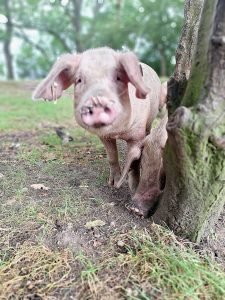From Forest to Table: How Pannage Balances Nature, Economy and Heritage
PUBLISHED ON: 13 SEPTEMBER 2024As autumn settles over the New Forest, a centuries-old tradition comes to life, pannage season. Pannage is the practice that allows local commoners to release their pigs onto the forest to forage for acorns, beechmast, nuts and seeds. Officially known as the Common of the Mast, pigs are allowed to explore the Forest typically from mid-September until mid-November, often returning ‘home’ at night to rest . Whilst it may seem like a quaint throwback to olden times, and an obviously delightful addition to the menagerie of free-roaming New Forest creatures, pannage is far more then that – it’s a vital part of what makes the New Forest so special.
One of the most important aspects of pannage is how it helps to protect the New Forest’s ecosystem. The pigs play a crucial role in reducing the number of acorns on the forest floor. In large quantities acorns can be harmful to the ponies and cattle, but pigs can safely consume them, and by doing so, help prevent potential poisoning of the animals that maintain the delicate ecological balance. In addition, as the pigs root around for food, they naturally turn over the soil, which increases biodiversity on the forest floor through aeration, and through the rooting up of pesky weeds.
Pannage season isn’t just good for the forest; it’s a gain for the local economy. The pigs, fattened up on acorns, produce special New Forest Pannage Pork— widely praised for its unique nutty flavour and rich colour. This pork is a valuable product, in high demand not only by locals, but by top chefs in restaurants across the country. Last year pannage ham won official registration under the government’s UK Protected Geographical Indication (PGI) scheme, as proof of its authentic origins. There is now a call for this to be recognised across the whole range of pannage pork products.

Commoner and New Forest Marque member Wendy Maughan puts her pedigree British Lops out for pannage every year. They start off on the local common, then when the season officially starts they venture into the Forest. Wendy keeps a close eye on her pigs, weighing them regularly to make sure they are getting enough food, and ensuring they are in top condition.
Wendy explains,
“The motivation comes from being able to produce quality meat for the community that has come from the Forest landscape. You can trace the origins from the land, to farm, to butcher, to plate, and that’s what is important; it’s local and sustainable, and you know the animals have been well cared for. “
Wendy enjoys the commoner way of life, but says it doesn’t come without its challenges, with safety for livestock being a primary concern,
“The worry is the roads and irresponsible drivers. Losing a pig or any animal to an accident, or worse – a hit and run, is devastating.”
The National Park Authority advocates for responsible road safety around animals, and works with the police and others to enforce and educate where they can, and it is an ongoing effort, especially as the nights draw in.

Supporting commoners is quintessentially at the heart of what the New Forest Marque local produce scheme sets out to do – championing local produce whilst preserving the New Forest’s heritage and landscape. Wendy is a proud member of the New Forest Marque because “it gives meaning to what we do”.
Pannage season 2024 runs from 16 Sept – 22 Nov
Pannage pork can be purchased from many New Forest Marque suppliers across the New Forest as listed in the Local Produce Guide directory here

